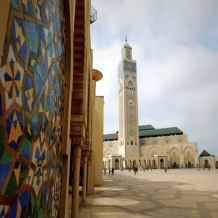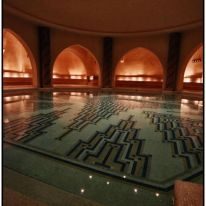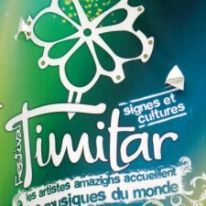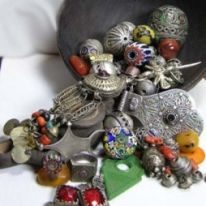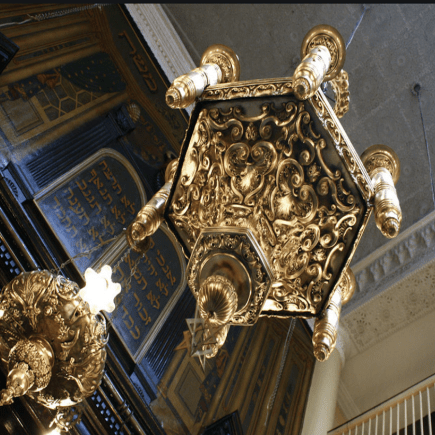
16 Moroccan Synagogues: Remnants of Jewish Life in the Imperial Cities and Great South
Morocco’s Jewish history dates back to as early as 70 CE when Jews immigrated to the region. They continue to co-exist in the Maghreb peacefully today yet in much smaller numbers. From early times the Jewish community in Morocco flourished. They lived throughout the Imperial Cities in the Jewish Mellahs and in remote rural regions among the Berbers surrounded by dotted landscapes. The Jews of Morocco designed magnificent synagogues adorned with imported and local materials, created a thriving business community whereby they became tailors, jewelry makers and sought after craftsmen. They celebrated births, weddings, and buried their dead in local cemeteries. Today, their foremost Rabbi’s are revered by Jews with Moroccan Heritage who come from abroad to visit the shrines and tombs that have been preserved.
A significant number of Jews came to Morocco in the 15th Century. Following the 1492 Alhambra Decree, many families fled Spain and arrived as refugees in the Maghreb. This second wave of immigrants gave Morocco it’s strong Sephardic identity and until the 1950s, the North African country became one of the most stable and desired places for Jews to build their homes. At its peak in the 1940s, there were approximately 350,000 Jews living in Morocco. Morocco was home to the largest Jewish community in the Muslim world and it remained this way until the founding of Israel in 1948. The majority of the population emigrated to Israel upon it receiving statehood
Although the kingdom does not officially recognize Israel as a state, the two nations have quietly maintained diplomatic ties for nearly seven decades. According to a 2011 Israeli government report, nearly 1 million Israeli Jews have at least some Moroccan roots. While many decided to leave post-colonial French, Morocco due to religious or economic reasons, Morocco has maintained its reputation for being one of the world’s most tolerant countries. Judaism has even been enshrined into the Moroccan constitution.
In 2011, King Mohammed VI, regarded as the highest religious authority in the country stated that he “protects Moroccan Jews living in Morocco.” In the same year, he also launched a Jewish Heritage program aimed to restore 100 synagogues, cemeteries, and reassign Jewish Mellahs (Jewish quarters) to their original names. As a result of the Kingdom’s support of past and present Jewish life within Morocco, Jewish travelers continued to visit the country.
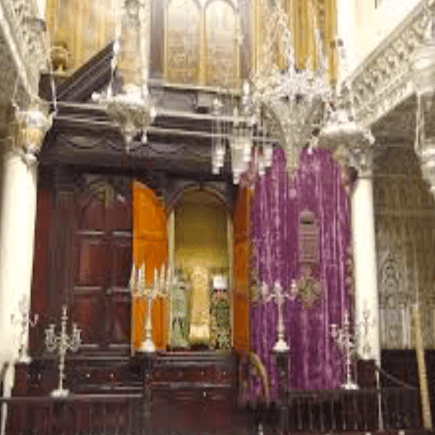
During past decades, visiting Morocco has also become popular among Moroccan-Israeli natives whose families live in Israel. They come to visit family, discover their roots or attend a Hiloula. Morocco’s television networks also feature in-depth shows about historic Jewish life. A new radio program called People of the Mellah was created to provide Jews the opportunity to share memories of their former lives in Morocco. While the current Jewish population in Morocco consists of about 2,500, it is still active and vibrant.
Since the launch of the King’s Mellah restoration plan, overseen by Serge Berdugo, the king’s personal Moroccan Jewish community advisor, over 167 cemeteries, 12,600 shrines, and dozens of synagogues have been restored.
In April 2019, King Mohammed VI began constructing a state-run Jewish Museum in Fes. Prior to this new plan for Fes, the Museum of Moroccan Judaism in Casablanca which opened in 1997, was the only one institution dedicated to Judaica in the Arab world.
There are also plans for two additional Jewish Heritage Museums, one of which will be built on a 1667 square meters area in the “Ville Nouvelle” of Fes. According to Mr. Berdugo, “creating a museum in the cradle of Moroccan civilization, where the imprint of Judaism has been the most striking… will show how for hundreds of years Jews and Moroccans created art of living together.” These construction projects preceded Mohammed’s VI’s news in April 2019 to revive the local representation for Morocco’s Jewish communities, which have been inactive since 1969.
Morocco’s attempts to restore its Jewish past is attracting visitors from around the world. In 2017, an estimated 50,000 Israelis visited Morocco. Regardless of having Jewish roots, many travelers want to discover this part of Morocco’s heritage. The country is home to hundreds of synagogues, shrines, and cemeteries in the Imperial Cities, Coastal and rural regions that tell a story of Morocco’s Jewish past.
Morocco’s Top 16 Synagogues are well-appointed within the Imperial Cities and Coastal towns yet remain hidden within the rural regions of the Great South. Exploring Moroccan Synagogues in their varied geographical locations and the remnants of Jewish History on a Jewish Heritage Tour will enrich your cultural experience as a traveler.
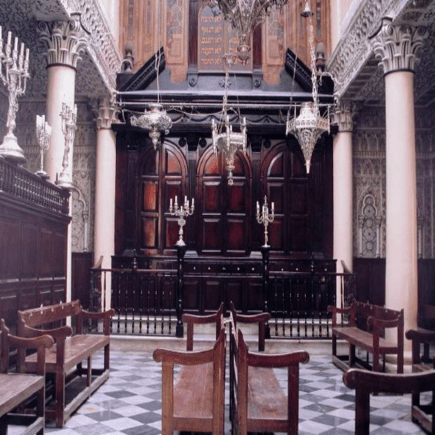
1. Moshe Nahon Synagogue (Tangier)
Moshe Nahon is located on a quiet street in the Beni Idir, Jewish Quarter. Considered one of the most beautiful synagogues in Morocco, this 19th-century house of worship was built by Moïse Nahon, a well-known Jewish scholar from Tangier. The synagogue was inactive until 1994. In the early 1990s, Jews from Tangier and the diaspora provided donations with the goal to restore the Moshe Nahon’s interior. The synagogue’s interior is designed in the Andalusian style. Elaborate designs of floral arabesques, Arabic calligraphy, and Islamic geometric patterns grace the holy site’s stucco walls. There are several glass chandeliers that open to a balcony and a courtyard whose entrance leads to an intimate prayer room. Moshe Nahon is located on Rue de la Synagogue, alongside other Sephardic homes and synagogues.
It is, however, the only synagogue open to the public. It also houses the Foundation Lorin, an art museum that displays vintage photographs of Tangier, contemporary paintings, and posters related to the political, sporting, musical, and social history of Tangier.
Address: Rue de la Synagogue, Beni Idir Medina Quarter, Tangier
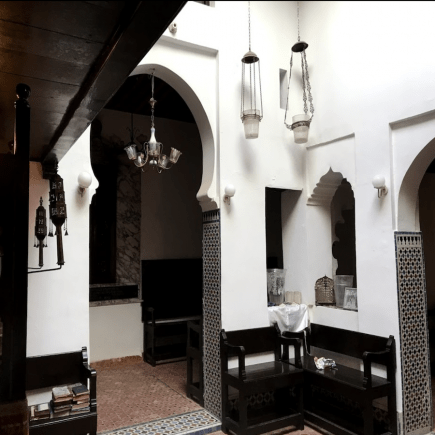
2. Isasc Ben Walid Synagogue ( בית הכנסת של יצחק בן) (Tetaoun)
Tétouan has a multifaceted history that traces back to both the Moors and Jews who fled Granda, Spain during the Spanish Inquisition. They created a new community in the Juderia and spoke Judeo-Spanish, a dialect that is comprised of both the medieval Spanish and Hebrew languages. Until the end of the 19th century, there were reports of over 170 homes and 16 active synagogues in Tetoun’s Jewish quarter. According to the El Noticiero de Tetouan, a census dated January 30, 1861, counted 11,000 inhabitants in Tetouan. Among them were 5,000–6,000 Jews. This 15th-century Jewish Moroccan history is what sets Tetouan apart and why it referred to as “Little Jerusalem.”
The principal house of worship in Tetoun is the Isaac Ben Walid Synagogue. Built-in 1889 and named after Rabbi Isaac Walid, it is one of the mountain town’s most influential Jewish sites. The Isaac Ben Walid Synagogue was commissioned by the Sultan Sliman, when the Sephardic community was at its peak. The synagogue includes a prayer room, an apparatus to control lights for the sabbath, a tribunal, a library, and an oven for baking unleavened bread. The synagogue’s architecture is in the Andalusian style and reflects the town’s history. Tetouan’s Jewish history can be observed in its Juderia’s street names. Among them are Dr. Angel Pulido, Prado, Bentolila, Isaac Bengualid, and Sultana Cohen. Until the end of the 19th century, many Tetuan Jews achieved economic success as traders with European countries. Apart from the synagogue, Tetouan’s Jewish sites consider a Jewish Mellah and cemetery located in the northeastern part of the city. Established over 500 years ago the Tetouan Jewish Cemetery has an estimated 10,000 tombstones. Philip Abensur’s Tétouan, cité marocaine aux racines andalouses (Tetuan, a Moroccan city with Andalusian roots) is recommended reading for more in depth information on Tetouna’s Sephardic Jewish History.
Address: 7 Isaac Bengualid, Tetouan
The Region of Fes and it’s Jewish Synagogues:
Fes, Morocco’s spiritual capital was considered the first city to establish an official Mellah ‘Saline Area’ in 1438. Similar other Mellah’s that followed, Fes’ Jewish quarters were situated near the waterways and built near the Royal Palace. The location of the Mellah in Fes and in Morocco was strategically placed by the King to enhance trading and to protect the Jewish quarters. While less than a few hundred Jews live in Fes today, the Mellah remains one of the most visited in Morocco. Historically, the Jewish quarter of Fes was organized into neighborhoods that had synagogues, yeshivas, a Jewish cemetery, and Kosher markets.
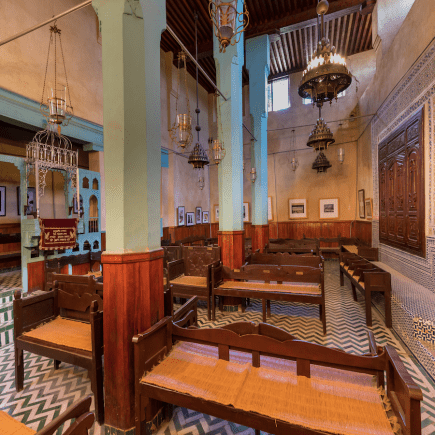
3. Ibn Danan Synagogue (Hebrew: בית הכנסת אבן דאנן, Arabic: معبد ابن دنان) (Fes)
This 17th-century synagogue is considered one of the most important in Morocco’s Jewish history. Prior to its restoration in the 1870s, the Ibn Danan Synagogue was quite run down. It was nominated in 1996 to be part of the World Monuments Watch Fund for a restoration.
In 1999, the Ibn Danan Synagogue was awarded a sponsorship by American Express in collaboration with Morocco’s Ministry of Culture and the Judeo-Moroccan Cultural Heritage Foundation. The grant provided money to restore it to one of Fes’ Jewish cultural treasures. The synagogue is laid out in Sephardic tradition with rows of seats facing towards the bimah and pulpit across from one other. Other points of interest include a peeping hole in the floor that looks into the mikvah bath. There is also a staircase that leads onto a roof terrace with views of the Jewish cemetery. The holy ground contains many of Morocco’s Jewish saints. Among them is Lalla Solica, who was killed for refusing to convert to Islam. The Ibn Danan Synagogue was built by Ben Mimoun Sidan, a wealthy merchant from Ait Ishaq.
Address: Fes el Jdid
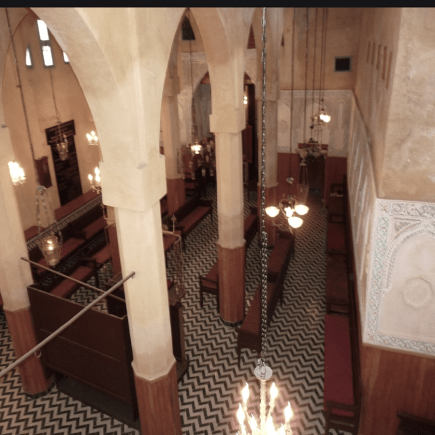
4. Slat Alfassiyine (Fes)
Slat El Fassiyine in Fes, is one of Morocco’s oldest and renowned, historic 17th-century synagogues. It is considered an architectural jewel of Fes and classified as one of the most beautiful synagogues in Morocco. According to the Times of Israeli, after years of neglect, this synagogue was transformed into a carpet-making workshop and then a gym, yet never lost any of its aurae as a place of worship or its beauty as an architectural work.
It was restored over a period of two years from 2011 – 2013. For it’s reopening in February 2013, Head of Government Abdelilah Benkirane delivered a message on behalf of King Mohammed VI in honor of its restoration partners. “We want to thank the Judeo-Moroccan Cultural Heritage Foundation and pay tribute to the Federal Republic of Germany, that have been in favor of the preservation. ” This is testimony to the richness and diversity of the spiritual components of the Kingdom of Morocco and its authentic heritage. Benkirane also referenced the new Constitution which protects the Jewish Heritage sites stating “that is why we call for the restoration of all the Jewish temples in the different cities of the Kingdom. They are no longer only places of worship, but also a space for cultural dialogue and renewal of the founding values of Moroccan civilization.”
Address: Fes el Jdid
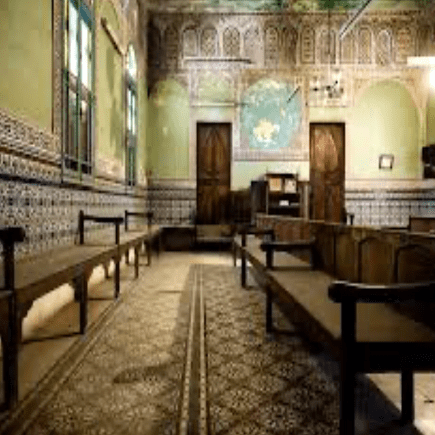
5. La Synagogue Em Habanim de Sefrou (Sefrou)
Sefrou is located in the Fes- Meknes region. The city is known for its annual cherry festival and a once-thriving Jewish community. Jewish pilgrims worshiped for centuries here and many refer to Sefrou as “Little Jerusalem.” Located in its rocky landscape is chiseled words appear that notate the “Cave of the Jew” signifying the Cave of the Believer, of which it is referred to by local Muslims who believe the prophet Daniel is buried here. Once a year on Lag ba’Omer, the cavern fills with the families of descendants. They come to pray like their ancestors did centuries ago.
The Em Habanim Synagogue in Sefrou is located at the foot of the Middle Atlas Mountains next to a now-abandoned elementary school for orphaned boys (1912-1960). The “orphanage synagogue”, features mosaic tiles from floor to ceiling still in good condition. Until 1956, there were nearly 5,000 jews in Sefrou. The town is connected to a local legend that says that the spirits of the Spanish Rabbis who taught Torah in the 1490s linger on in the caves.
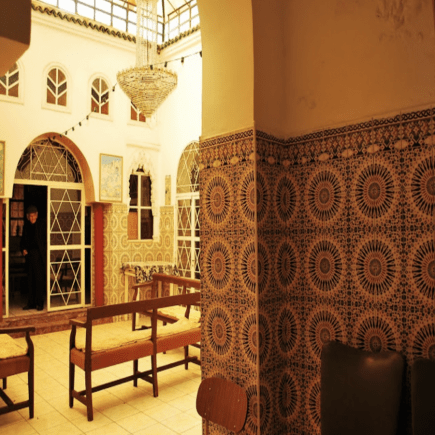
6. The Great Rabbi Chalom Zaoui Synagogue (Rabat)
Rabat’s Mellah once housed as many as 25,000 Jews and its nearby coastal town Sale also has a Jewish Mellah. The new Jewish quarter is comprised of 200 houses, 20 shops, trading booths, two kilns, and two mills. According to Diarna, Jews occupied prominent positions in the administration of Rabat, serving as ambassadors to European powers with commercial interests in Morocco.
Sephardic Jews arrived in Rabat and northern Morocco in the 15th century from Spain during the inquisition. They were driven out of Andalusia and those who came to Rabat settled within its historic medina. Later in 1806, the Jewish Mellah was built upon request from Sultan Moulay Slimane who commanded its creation in order to house the Jewish population of Rabat. The Mellah was built within the medina’s walls on the site of fruit orchards. The site was chosen since it was within the walls of the Medina. Similar to other Mellah’s in Morocco its purpose was both separation and protection for the Jews.
Located in the Mellah on Henri Popp Street, Chalom Zaoui is considered the most famous synagogue in Rabat. On the same street, is the Talmud Torah synagogue school. The Chalom Zaoui synagogue has a Moorish style visible from trilobal shapes on the windows, lamps resembling mosque lamps, and ceramic tiles with geometric forms. The synagogue was at one time also the home of the Rabbi however during the restoration in the last decade, a new plan was developed to include a courtyard with arcade, a shrine, and storage. A mikvah bath was installed near the entrance to the synagogue and the courtyard along with an oven.
Chalom Zaoui is marked with stars of David that are featured on its door. It is well-appointed in Bab Diouna and abuts the Muraille Andalouse.
Address: Henri Popp Street

Essaouira was once home to 48 synagogues with two of the most important being the Simon Attias and Chaim Pinto.
Located on the Atlantic Coast, Essaouira, formerly Mogador, was once hosted to 48 synagogues and a burgeoning Jewish community. Many Jews came as refugees from Portugal. They worked in the sea trade and with camel caravans that supplied goods from the sub-Sahara. Although the coastal town’s Jewish population has long relocated, the city holds an annual Atlantic Andalusia Music Festival that continues to celebrate Essaouria’s deeply rooted history and Judeo-Arabic culture.
7. The Simon Attias synagogue (Bet Ha-Knesset Simon Attias, M’sod Attias ( בית תפילה ) (Essaouira)
Among Essaouira’s Jewish Heritage sites, is the nineteenth-century Simon Attias Synagogue. It is also known as the Bet Ha-Knesset Simon Attias, M’sod Attias and Shaarei T’filah. The Simon Attias Synagogue was built in 1882 in former Mogador, now Essaouira. It sits off Rue Laalouj in the Kasbah, just beside the former British consulate.
The temple was built in a Sephardic style and named after a local Jewish merchant. It had a masonry wing and courtyard that once contained the home of Simon Attias. The ground floor once held shops, the prayer room is on the second floor, and the third floor contained the offices of Jewish courts. The temple featured large arched windows, mahogany woodwork carved in London, and a cedar Torah Ark decorated in floral carvings.
In 2009 Simon Attias closed and underwent an exceptional renovation, reopening to the pubic in 2019. The renovation was a success with the synagogue being converted to a future cultural center of reflection and research. It will bear the name of the contemporary historian Haim Zafrani, who originated from Essaouira. Guaranteeing the preservation of Moroccan Jewish heritage the synagogue also houses a gallery of memory, that displays pictures of the past and present of the Jewish life, a library, museum along with places for reflection and debate. It is the second-largest synagogue in Morocco.
Address: 119 Rue du Mellah, Essaouira 44000, Morocco
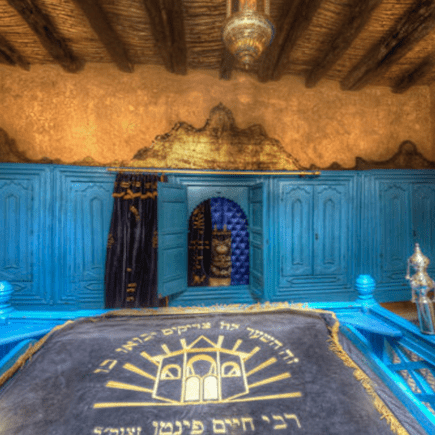
8. Chaim Pinto (Essaouira)
The Chaim Pinto Synagogue in Essaouira, Morocco was once the home and synagogue of Rabbi Chaim Pinto. While there is no longer a thriving Jewish community in Essaouira, the building remains active synagogue, used when pilgrims or Jewish tour groups visit the city for annual hiloulas (festivals of annual patrimony). The synagogue is on the second floor of a three-story, courtyard building nestled inside the walls of the Mellah which once contained Rabbi Pinto’s home and office. The building is of whitewashed plaster over masonry. The synagogue consists of a single large room. There are two women’s sections, one across the courtyard and one on the third floor, both with windows looking inwards to the synagogue’s ark. The synagogue room underwent a modern renovation in line with the policy of restoring Morocco’s Jewish synagogues announced by King Mohammed VI, concealing the ceiling and column capitals, along with painting the wood of the Torah Ark and Bimah light blue.
Address: Jewish Mellah
Casablanca’s historic synagogues are significant along with its Jewish population of which today remains, the largest in Morocco.
Morocco’s largest concentration of synagogues is in the bustling economic capital of Casablanca. It is home to the largest Jewish community in the Arab world. The white city has the only Jewish Museum in the Muslim world, 30 synagogues, several kosher restaurants, butchers and bakeries, a Jewish cemetery and many Jewish schools, Out of the 3,000 Jews living in Morocco, most live in Casablanca. This whitewashed city on the Atlantic is also known for its Grand White Hassan II Mosque and vibrant corniche.
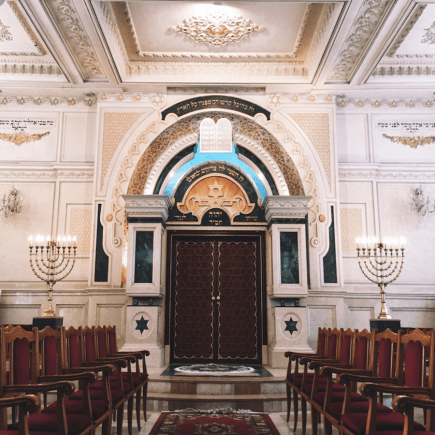
9. Temple Beth-El or “Beit-El” בית הכנסת בית-אל) (Casablanca)
Temple Beth El is considered one of the most beautiful synagogues in Morocco. It is referred to as the Algerian Temple because it was established by Algerian immigrants. A centerpiece of the once vibrant Jewish community, Temple Beth El is where the majority of Jews who reside in Casablanca come to pray and celebrate religious holidays and events Among its striking characteristics include stained glass windows, giant chandeliers, and architecture of white and gilded plaster. It is an orthodox Jewish temple led by Rabbi J. Azuelos. Beth El was completely refurbished in 1997 and is located in the new city of Casablanca, near the Chabad
Address: Rue Jaber Ben Hayane
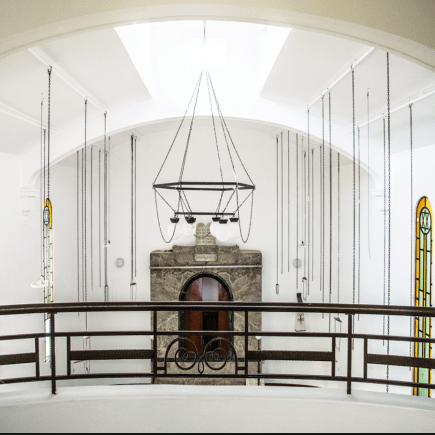
10. Ettedgui Synagogue (Casablanca)
Ettedgui Synagogue is well appointed in the Casablanca Medina. The house of worship is located alongside the El Mellah Museum where paintings and photographs are exhibited that retrace the history of Judaism in Morocco. It was one of a dozen synagogues that received funding for restoration and that King Mohammed VI personally attended for its celebratory reopening. The original founders, the Ettedgui family were once considered part of the bourgeois community of Casablanca. The land was registered in the cadastre 1873 and carried the legacy of the “Makhzen,” with the French protectorate welcoming the construction of the synagogue in 1920. It was partly destroyed in error, during the bombing of the allies in 1942. Ettedgui was then rebuilt in the 1980s with the complete reconstruction finalized as part of the rehabilitation project of the old medina of Casablanca launched by the Sovereign in 2010. This synagogue is steeped in history and remains a symbol of openness and of peace between Moroccan communities.
Address: Rue Al-Aidi Ali Al-Maaroufi
The Jews of Marrakech fled Spain during the Inquisition and settled in this popular ocher city of the South. Similar to Morocco’s other Imperial Cities, Marrakech is home several historic synagogues.
Marrakech’s Jewish history dates back more then five centuries ago when the Sephardic community was forced to flee Spain during the Inquisition. Many chose to go to Northern Morocco. At the time of their arrival, the Sultan of the Saudi dynasty built a Mellah and invited the Jewish community to live in private courtyards. While there are few Jewish who live in Marrakech today, there are still several thriving synagogues. Notable rabbis who practiced in Marrakech include Rabbi Avraham Kurkus and his disciples, Rabbi Avraham Pinto, and Rabbi Shlomo Amar. In 2019 Spain’s attempt to atone for a 500-year-old sin has been to offer citizenship to Jews whose families it expelled in the 15th century.
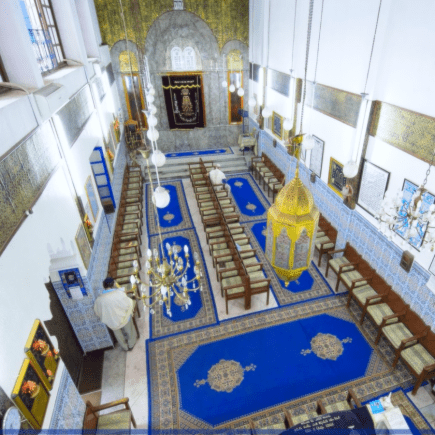
11. Slat Al Azama (Tzalat al-Azma) Synagogue (Marrakech)
Slat Al Azama was the first synagogue built in Marrakech intended to accommodate the Jewish community who fled from Spain. It is located on a quiet street and protected by guards. Intimately-designed, it was built around a central courtyard, using a model of traditional Moroccan architecture. The synagogue was recently renovated and now includes a gallery for women. There are two floors, of which the second floor was once used for Hebrew school lessons. There is also a small galley that showcases vintage photographs of the Jewish-past which feature the historic Mellah and style of dress of the time. Slat Al Azama holds services daily from Monday through Thursday at 7:30pm and also on Shabbat. Located nearby is the Miara cemetery that holds the graves of the once-thriving Jewish community including those of renown Rabbis.
Address: Talmud Thora Street, Mellah.
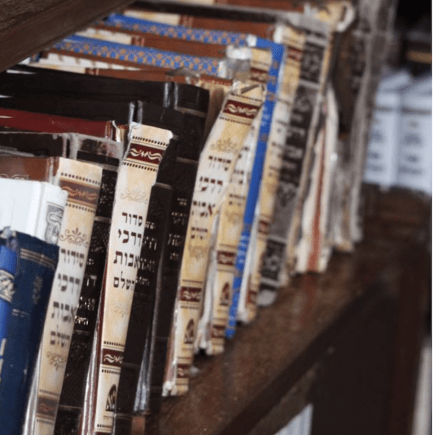
12. Beth El Synagogue Gueliz (Marrakech)
The Marrakech Beth El Synagogue is located opposite the American centre in the modern town of Guéliz. It is presided over by Jacky Kadoch.
Address: Place Zerktouni, Marrakech Gueliz
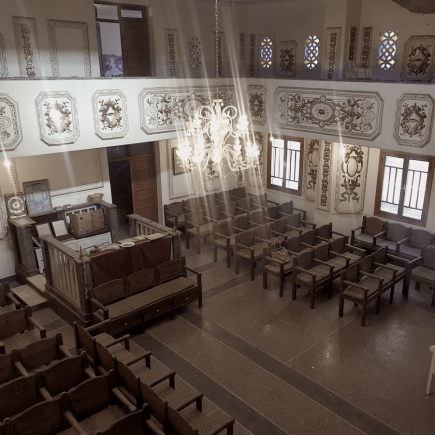
13. Rabbi Yossef Bitton Synagogue (Marrakech)
This private synagogue is well-appointed near the gates of the Jewish Mellah. Established by Rabbi Yossef Bitton the house of worship is now owned and run by Charly Bitton, the grandson of Yossef Bitton. Charly Bitton is one of the few Jews who did not emigrate to Israel when it became a state in 1948. The family-owned synagogue’s ark has a Torah with holy scrolls that are nearly a century old. This house of worship was one of the few synagogues worldwide that allowed all to pray for on a no-fee basis. Inscribed on a plaque hanging in the temple room are the wishes of Youssef Bitton. “No Jew, rich or poor, will ever pay to pray in the synagogue.” Bitton claims “even if there was one remaining Jew living in Marrakech, the synagogue must remain open.” Rabbi Bitton was one of the wealthiest Jews in Morocco. After he returned from World War I in France, he made his fortune selling food packages to the soldiers. He is buried alongside his family in the Miara cemetery. The temple is currently inactive however it is possible to schedule a visit.
Address: Ksibat Nhass, Mellah
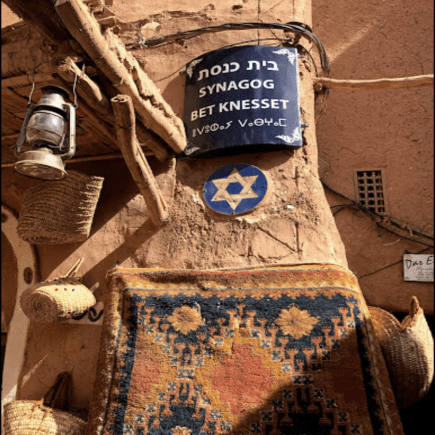
14. The Old Synagogue בית כנסת (Ouarzazate)
Located in Ouarzazate, the Old Synagogue is thought to be nearly 300 years old. It was an active house of worship until 1959. Since then, it has been turned into a family-owned gallery presided over by Ayouv Ben Hamou. Ben Hamou claims to be from one of the last Jewish, Berber families of the Sahara region. Upon entering the Old Synagogue visitors are guided through the gallery by Hossain and Ayoub el Boulmani, Hamou’s sons. These caretakers enjoy reciting the history of Morocco’s Jewish past and sharing the story of how their father bought the Old Synagogue from Muire Muler, the “last” jew who left the Sahara.
Address: Taourirt Kasbah, EL Melah, Synagogue
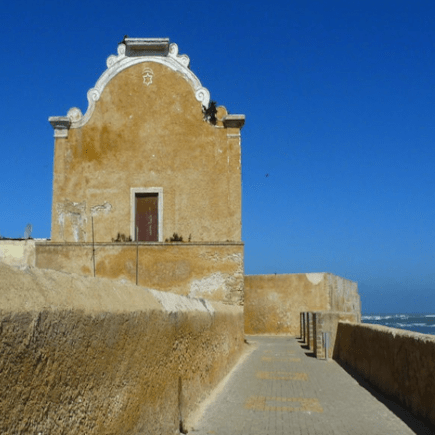
15. Bensimon Synagogue (El Jadida)
The Bensimon Synagogue originates from a notable family who was the prior leaders of the Jewish community of El Jadida. The Bensimon’s marked the history of the city with this historic building, a synagogue that bears the family name and where the Jdidi Jews worshiped peacefully.
At the beginning of the 20th century, in 1926, Nessim Bensimon and his three Messaoud brothers, Abraham and Mordechai built the synagogue and dedicated the house of worship to the memory of Nessim’s first wife, Sulika, who died during childbirth. It officially bore the Hebrew name of “Sha’arHashamayim” meaning “the gates of Paradise,” The synagogues floor and altar are made with marble imported from Italy and it once retained a library with books and spiritual writings on the Jewish religion. Over the last century, the synagogue has become increasingly dilapidated due to abandonment, the effects of time and the departure of the entire Jewish community.
Today the Bensimon Synagogue is currently the subject of a potential rehabilitation project and a planned transformation into a museum devoted to Jewish culture. The interest in restoration arose from an article written by Mustapha Jmahri in February 2018 and entitled “The Bensimon synagogue in El Jadida defies time.” This piece caught the attention of an heiress of the Bensimon family from England, named Marlène Bensimon. She had practiced in Casablanca as a teacher and on behalf of the family, in this case, the descendants of Nessim, Messod, Abraham, and Mordechai who live in the USA, expressed the wish to transform the old synagogue into a museum.
The Bensimon Synagogue project consists of transforming the building into a museum and making it a space for cohabitation, dedicated to cultural activities and exchange. Given its prime medina location on Abdelkrim Khattabi square, the anticipation is that the restoration will revive the secular square and offer it a particular cachet.
Address: El Jadida Medina, Jewish Mellah
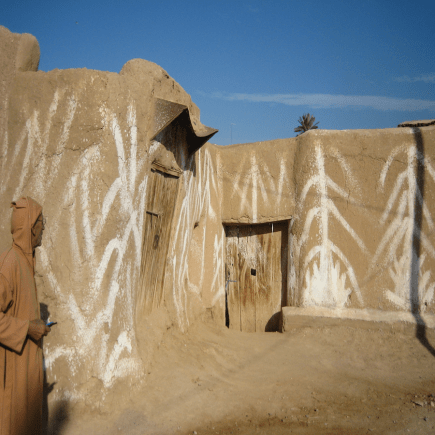
16. Adobe Synagogue at Arazane (Arazane, Tarodaunt)
The remarkable 800-year-old Adobe Synagogue of Arazane is believed to be the only of its kind in the world. Hebrew prayers are painted on its wall and its ark is adorned with Amazigh (Berber) decoration and writing. Arazane, a town outside Taroudant, and was first rediscovered in the late 1980s. According to Diarna, at that time, it was still looked after by Harim, a local Amazigh (Berber), who kept the building’s key safe for decades. Harim, who is now over 75 years old, has held the key in trust, fulfilling his promise to the Rabbi when the Jews left the village in 1960, that he would give the key to any Jew who came asking for the Synagogue.
Originally inside the Adobe Synagogue at Arazane was a pile of hay, as well as Hebrew writing and an old ark for holding Torah scrolls. The key and door lock that secures the synagogue is ancient. Still standing and restored is a small sanctuary and a mikveh bath. Visitors today can view the synagogue and meet Harim, the old guardian, who still recalls the Hebrew prayers of his Jewish neighbors 45 years after they left.
Diarna (דיארנא ديارنا “Our homes” in Judeo-Arabic) is a Geo-Museum of North African and Middle Eastern Jewish Life working to digitally preserve the physical remnants of Jewish history throughout the region.
Written & Contributed Reporting by Marina Solovyov & Alecia Cohen
For more information about a Moroccan Jewish History or a Moroccan Jewish Heritage Tour.

